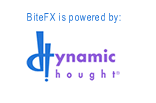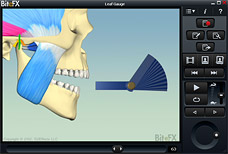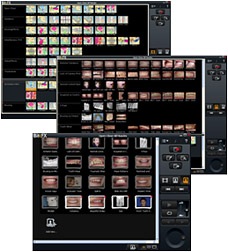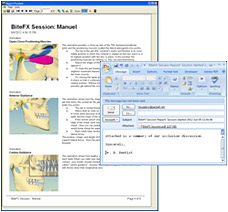BiteFX on Windows
Click here for BiteFX on iPad details
Highlights
Main Benefits
Detailed Features
Photographs
Interface
Guidelines
Overview
BiteFX helps you communicate the key concepts of occlusion to your clients. Because your clients can see how their bite ought to work they are better able to accept your treatment recommendations. Explaining occlusion need no longer be a challenge - BiteFX gives you the visual explanations that make things obvious.
If you have an earlier release of BiteFX, you should read Upgrade to BiteFX V2.0w for Windows.
Highlights
- Over 60 animations based on 3D computer models of the skull, jaw and teeth
- New animations added regularly for BiteFX subscribers
- High resolution, dental pictures available to give real examples of the effects being described
- Ability to add in your photographs either to tailor presentations to particular patients or enhance the collection of pictures within BiteFX
- Easy to use interface designed to help you present the concepts to your patients
- Establishes you as a technically-savvy expert on occlusion
Main Benefits
- Increases case acceptance for occlusion-related treatment plans (most say BiteFX pays for itself within the first couple of weeks)
- Saves time as, with BiteFX, explaining occlusion-related treatment plans takes much less time.
- Helps staff understand occlusion and get onboard with the occlusion-related treatments
- Enhances relationship with the patient as BiteFX puts you clearly in the position of being the expert
- You no longer get those "blank stares" when explaining occlusion to your patients
Detailed Features
BiteFX helps you communicate many occlusally-related concepts of which the following is a sample list:
- Proper position of the TMJ
- Elements of the TMJ assembly
- Function of the bi-concave articular disc
- Need for TMJ to be fully seated with teeth contacting simultaneously
- Centric relation
- Centric occlusion and maximum intercuspation
- Opening/closing motion of the jaw
- Normal coordinated muscle function (digastric, masseters, temporalis, lateral pterygoids)
- Muscle functions: opening, closing, positioning
- Only closing muscles in tension when the bite is closed
- Coordinated activity of the upper and lower pterygoid muscles
- Anterior guidance - forward and sideways movement
- How molars should separate with healthy anterior guidance
- Why fixing front teeth first makes sense
- How molars should contact (peaks to valleys)
- Why quality lab work is important
- How all teeth should come together
Having helped you establish an understanding of the stable bite, it illustrates these elements of a destructive bite:
- TMJ not in centric relation
- Lateral pterygoid overwork to hold jaw on slope of eminence
- Strain on the articular disc
- Articular disc distortion over time
- TMJ disorders are a progressive disease
- Causes of jaw clicking
- Cause of jaw locking
- Possible TMJ bone deterioration
- Bruxing molars and its effects on:
- Teeth (loosening, wearing, fracturing)
- Muscles
- Nerve sensitivity
- Bruxing canines and the effects of loss of canine guidance:
- Molar loosening
- Abfractions
- Gum and bone recession
- How incorrect molar contact can lead to loosening teeth
- Effects of lack of anterior guidance on the molars:
-
- Nerve sensitivity
- Root canal problems
- Wear
- Looseness
- Gum and bone recession
- Fractures
- Why interference effects produce a repositioning of the jaw in a more comfortable bite position:
- Balancing interferences
- Fremitus
- Restricted envelope function
- Knife-edge front tooth wear
- Mal-occlusion leading to total dentition destruction
- TMJ causes of headaches
- How food gets stuck between apparently close-fitting teeth
- How jaw position can change between taking an impression and fitting a crown on a rear molar, and hence why it is important to establish a stable jaw position before taking impressions.
BiteFX then helps you explain the following treatments:
- How use of a splint/orthotic can help seat the jaw and ease or remove symptoms
- Detailed features incorporated into the design of a proper full coverage splint such as having a great fit, multiple contacts when the jaw is fully seated, angle of the contact plane, and anterior guidance
- Full coverage and anterior splints/orthotics shown
- Use of a leaf gauge
- Equilibration
- Rebuilding a totally destroyed dentition
- Use of implants
- How taking bite impressions with the jaw fully seated avoids problems when fitting crowns on rear molars
Photographs
A collection of occlusion-related photographs are provided which can be integrated with your presentations and selected easily at any time by clicking on the Picture button ![]() .
.
Examples of photos:
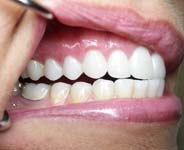 Forward anterior guidance
Forward anterior guidance
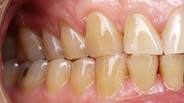 No canine guidance
No canine guidance
 Close-up of worn teeth
Close-up of worn teeth
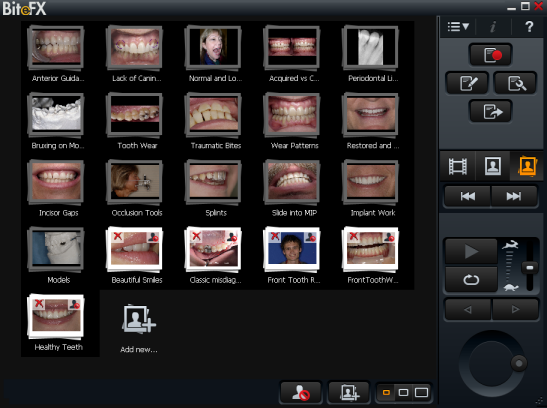
Interface
The BiteFX interface is designed for easy, intuitive use.
Animations, pictures and albums are selected from panel displays. Animations are played using standard video-player-style controls or by dragging sliders. Recordings are made using the record on/off button, explanatory notes edited, and the resulting report emailed, printed or saved for your patient.
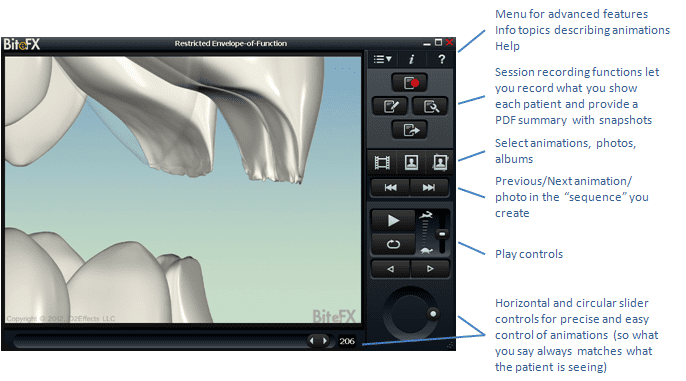
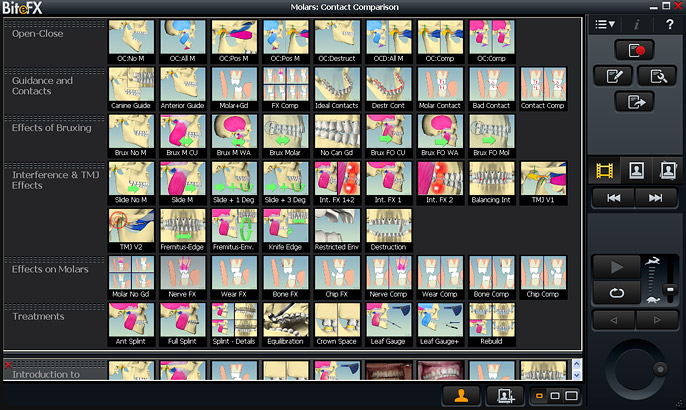
Guidelines
BiteFX provides the following guides and documentation to help you make the most of the product:
- Welcome and Help Instructions: When you first invoke BiteFX, and any time you press F1, you see a pane that gives basic instructions on using the product.
- Info Pane: The Info button
 is always available to bring up a list of points that describe the current animation. A useful introduction to each animation or reminder of points to communicate.
is always available to bring up a list of points that describe the current animation. A useful introduction to each animation or reminder of points to communicate. - User Guide: Detailed description of all parts of the product and how to use it.
- You might also like to read Learning to Use BiteFX
(+1) 530-582-1189
What people are saying about BiteFX::
scheduled for a full mouth of much needed cosmetic dentistry.
